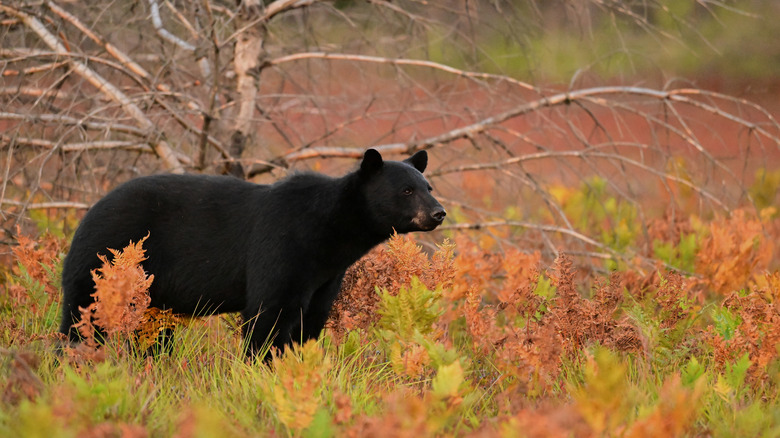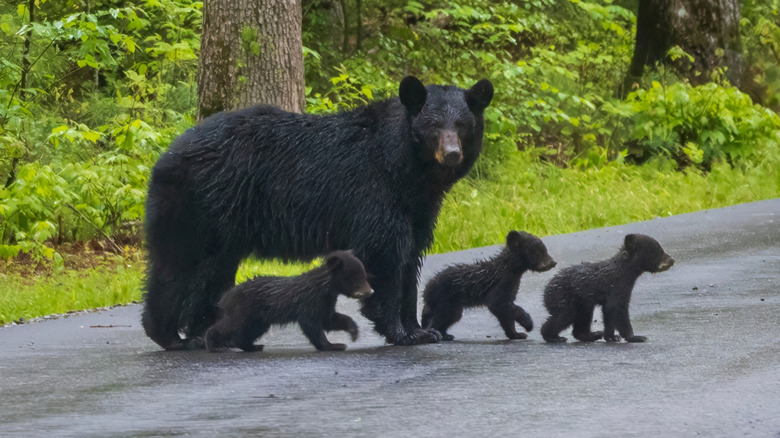The Brief Season When It's More Important Than Ever To Be Bear-Aware
America's public lands protect some of the most pristine wildernesses in North America, and with them come all of the animals that make these parks their homes. Unfortunately, human civilization is ever encroaching on their habitats, and wild animals are increasingly coming into close contact with people, far more than would be ideal for either. The most fearsome animal residents of the United States are arguably its extensive population of black and brown bears.
While most of these ursine residents prefer to keep to one of the national parks where you're almost guaranteed to see a bear, these furry omnivores do sometimes venture out into the human world in search of food. Safety protocols are essential for park guests, or even anyone who lives near forested areas where the animals might venture. However, while protective measures are important year-round, they are especially crucial during one brief but significant period — a time in a bear's life known as hyperphagia.
For all its pretentious Greek derivations, the word "hyperphagia" really just means "eating a lot." Bears, of course, eat a lot all the time. However, their already formidable appetites go into overdrive during their lead-up to their winter hibernation. With bears looking to get fat in preparation for winter, black and brown bears across the country will seek out food more voraciously than before. This means that encounters with humans become more likely, as the animals may wander out of their normal habitats in search of food. During the fall months, it's particularly important to be "bear aware" and minimize the risk of bears developing a taste for human food, for the safety of both.
What exactly is hyperphagia?
One of the basic facts that most people know about bears (alongside their love of honey and penchant for going to the bathroom in the woods) is that they hibernate in the wintertime. During the cold and lean winter months, black and brown bears often retire to a den or nest to sleep through to spring. To stay alive, the bear's body converts its fat into essential energy. Three months is a long time, of course, and to survive the entire winter, a bear must have fairly sizable fat reserves. This is where hyperphagia comes in.
As summer transitions into fall, bears take their dining habits to the next level. The average bear generally needs to consume around 20,000 calories per day to ensure survival during winter hibernation. This means they spend about 22 hours of their day during hyperphagia either eating or looking for food. It also means that bears really start to pack on the pounds. While calling a human "fat" is rightfully considered rude year-round, during hyperphagia, the label is actually a compliment for them. By the time it's ready for hibernation, a healthy bear will have increased its body mass by 20%-30%.
These newly rotund figures can be entertaining, as seen at the annual Fat Bear Week at Alaska's underrated Katmai National Park & Preserve. However, it also brings some risks. In the wild, these animals should be fattening up on natural foods, like fish, meat, berries, nuts, insects, roots, and even greens. Bears are not picky, though, and they'll just as happily eat human food as they would their natural diets. While they actively seek out food during fall hyperphagia, the possibility of interactions with humans becomes much greater — as does the potential for tragic outcomes.
How to keep bears — and yourself — safe as they prepare for winter
During hyperphagia, the animals are more likely to actively seek out food by wandering far beyond their normal habitats and into human environments. In bear-heavy Colorado alone, over half of all incidents with humans in 2023 occurred between August and October. As autumn food can be the difference between life and death during winter hibernation, bears in hyperphagia can become aggressive with people, resulting in potentially serious injuries (or even death). And the threat isn't just for humans. If a bear gets too acclimated to human food, it can lose its ability to feed itself on its natural diet. This means it will be less likely to survive in the wild, while losing its natural fear of humans. Sadly, the most likely outcome of this scenario is euthanasia.
Safety is critical during fall hyperphagia season. The basic bear safety protocols for hiking and camping apply doubly when the animals are in search of winter food, and (as any well-traveled camper will know), most involve proper food storage. If you are camping during the fall, always store your food in bear-resistant food canisters, keep all edible or scented items within arm's reach, wash all dishes thoroughly, and take all food waste with you. If you live near bear country, keep your garbage (a popular buffet option for hungry bears) secured, clean all garbage cans and grills, and remove bird feeders and other potential sources of outdoor food. And, of course, never try to feed any you encounter. By being bear aware, you can help our furry neighbors survive another winter and ensure we can live side-by-side in peace.


